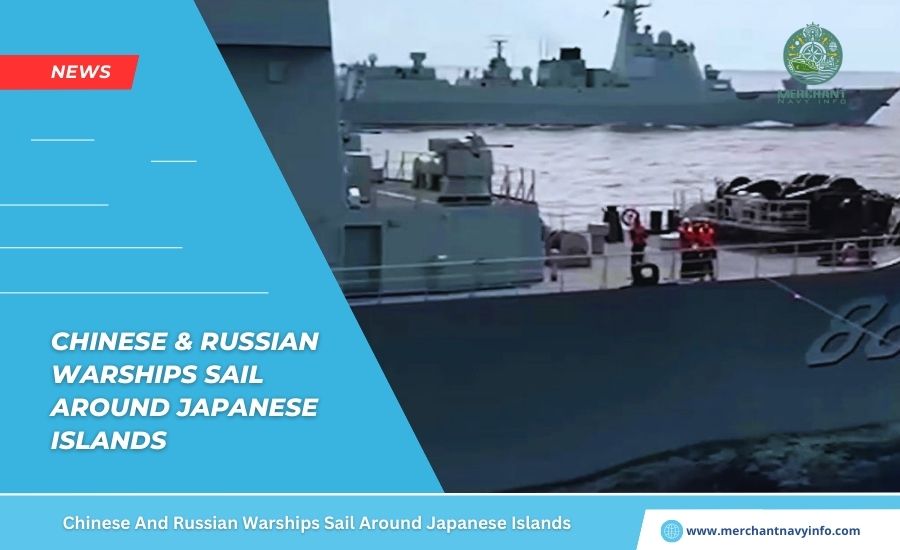
Chinese And Russian Warships Sail Around Japanese Islands
According to a press release issued by the Japanese Joint Chiefs of Staff on Monday, the Chinese People’s Liberation Army Navy destroyer CNS Kaifeng (124) and frigate CNS Yantai (538) were spotted sailing northwest 31 miles south of Yonaguni Island. Then, north into Japanese waters between the island of Yonaguni and Taiwan. The two ships were later spotted in the East China Sea 43 miles west of Uduri Island.
At 1 a.m. local time, the Chinese cruiser Lhasa (102) and the tanker Hoh Xilhu (903) were spotted sailing north in an area 43 miles east of Miyako Island. Then, heading north into the waters between Miyako Island and Okinawa Island, entering the East China Sea. According to the statement, the destroyer JS Kirisame (DD-104) of the Japan Maritime Self-Defense Force (JMSDF) stationed at Kanoya Air Base and a P-1 Maritime Patrol Aircraft (MPA) of the First Fleet Air Wing of the Japan Maritime Self-Defense Force was tracking the Chinese naval vessels.
Meanwhile, according to a second JSO statement on Monday, the Chinese Navy’s Dongdiao-class surveillance ship Venus (799). It was spotted sailing north in an area 37 miles south of Yonaguni Island at around 7 a.m. local time on Sunday. The Venus then sailed north into the waters between Yonaguni Island and Shimoti Island.
Japanese ships and aircraft also monitored Russian ships sailing near the country.
The ship was later seen sailing north in an area 43 miles west of Utsuri Island in the East China Sea. The statement said Chinese naval vessels spotted the Kirisame. A 5th Fleet Air Wing based at Naha Air Base in Okinawa. A Japan Maritime Self-Defense Force P-3C Orion MPA aircraft.
On Tuesday, Japan Air Self-Defense Force fighters took off in the Western Air Sector. In response to a Chinese WZ-7 reconnaissance aircraft that took off from Anami Oshima and flew between Kyushu and Okinawa. Several Chinese and Russian ships and a Chinese drone flew around Japan on Sunday and Monday, according to the Japanese Joint Chiefs of Staff.
Russian Navy frigates RFS Sovetskaya Gavan (350) and RFS Koryeyets (390). JSO Image
At about 6 a.m. Saturday, Russian frigates RFS Sovetskaya Gavan (350) and RFS Koryeyets (390) were spotted heading east in the area 31 miles northwest of Ripon Island. They then sailed east through the La Perouse Strait.
At noon the next day, frigates RFS R-298 (971) and RFS R-261 (991) were spotted heading southwest in the area 31 miles northeast of Cape Soya, the northernmost tip of Hokkaido’s main island.
The two Russian frigates sailed west through the La Perouse Strait into the Sea of Japan. A statement from the Joint Task Force reported that the fast attack ship JS Wakataka (PG-825) of the 2nd Fleet Air Wing. Based at Joint Task Force Hachinohe Air Base on the main island of Honshu. It conducted surveillance operations against the Russian vessels using P-3C Orions MPA aircraft.
Several Chinese and Russian ships and a Chinese drone flew around Japan on Sunday and Monday, according to the Japanese Joint Chiefs of Staff.
Russian naval vessels frequently pass through the La Perouse Strait. An international waterway between Hokkaido and Russia’s Sakhalin Island, and sail between Japan and the Sea of Okhotsk. Japan views Russia and China as threats to its security and has Japanese joint task force ships and aircraft regularly monitor ships from both countries operating near Japan.
In a recent show of force, Chinese and Russian warships sailed around the Japanese Islands from June 30 to July 1. The Chinese warships Kaifeng and Yantai entered the Pacific Ocean through the Tsugaru Strait. While the Lhasa and Kikishirihu passed through the La Perouse Strait and entered the Sea of Okhotsk. Russian frigates RFS Sovetskaya Gavan and RFS Koryeyets were also spotted heading east through the La Perouse Strait. This activity is likely an attempt to intimidate Japan, which has been increasing its military cooperation with the United States.
The U.S. Coast Guard may have spotted four Chinese naval vessels in the U.S. exclusive economic zone between July 6 and 7. These corridors are permitted by international law.
“The Chinese Navy’s actions are consistent with international rules and norms,” Admiral Megan Dean, commander of the 17th Coast Guard Squadron, said in a Coast Guard statement. Plus, “We met presence with presence to ensure that U.S. interests in the maritime environment around Alaska are not interfered with.”
However, the Coast Guard statement did not disclose that the ships belonged to the Chinese Navy. Furthermore, the Chinese ships responded to the U.S. Coast Guard’s communications with the stated purpose of “freedom of navigation operations.”
Japan and the United States began the “Resolute Dragon 24” exercise.
Meanwhile, on Sunday, the U.S. Marine Corps and the Japan Ground Self-Defense Force began the “Resolute Dragon 24” exercise in Japan. According to a Marine Corps statement, the exercise will be held throughout Japan and last until August 7.
“The Resolute Dragon exercise embodies the long-standing partnership between the U.S. Marine Corps and the Japan Ground Self-Defense Force,” said Lieutenant General Roger Turner, commander of the U.S. Marine Corps’ Third Expeditionary Force, at a press conference.
Furthermore, Lieutenant General Roger Turner, commandant of the U.S. Marine Corps, said in a statement from the III Marine Expeditionary Force that the Resolute Dragon demonstrates the long-standing partnership between the U.S. Marine Corps and the Japan Ground Self-Defense Force. Additionally, “Together, we seamlessly integrate multi-domain joint operations and are ready to respond immediately to any crisis.”
The statement said about 3,000 U.S. sailors and Marines will train with the Japan Western Ground Self-Defense Force.
“Resolute Dragon 24 will include training activities such as the deployment of TPS-80 radars on Yonaguni Island, low-altitude bilateral training with U.S. and Japanese V-22 Osprey aircraft. And live-fire training at multiple locations,” the statement said.
Yonaguni Island, located 68 miles east of Taiwan, has been identified. As a key area in Japan’s plan to defend its southwestern islands and the disputed Senkaku Islands. Japan controls the islands but claims them from China and Taiwan. Japan plans to install surface-to-surface missiles on the island soon. Plus, join radar stations on the island to monitor Chinese military operations in the region.
Final Thoughts
The Japanese Ministry of Defense announced on Tuesday that the Royal Canadian Navy (RCN) frigate HMS Montreal (FFH336) conducted surveillance on illegal maritime activities from mid-June to late July.
These included ship-to-ship transfers using North Korean-flagged vessels in waters around Japan, which is prohibited by UN Security Council resolutions. The statement noted that this was the ninth time the RCN ship had conducted the mission since 2018.
Above all, the Chinese military has previously harassed Canadian and Australian ships and aircraft on surveillance missions. But no such incidents have been reported in connection with the recent Montreal mission.
China has consistently claimed that UN surveillance missions are a cover for Chinese reconnaissance missions. The Chinese military always acts legally and professionally in such encounters.
After completing the surveillance mission, Montreal conducted an at-sea replenishment exercise with the Japan Maritime Self-Defense Force fleet tanker JS Tokiwa (AOE-423) on Monday in the East China Sea. However, on Tuesday, it conducted bilateral operations with the destroyer USS Ralph Johnson (DDG-114) in the East China Sea.









